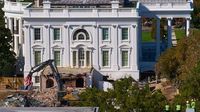In a move that has stunned Washington insiders and historians alike, the East Wing of the White House—a space long regarded as the symbolic heart of the presidential residence—has been demolished to make way for President Donald Trump’s ambitious new ballroom project. The demolition, which began on October 20, 2025, has not only erased an iconic part of American history but also highlighted the increasingly distant role of First Lady Melania Trump during her husband’s second term.
For more than a century, the East Wing served as the headquarters for first ladies and their staff, hosting everything from state dinner planning sessions to major policy initiatives. Betty Ford once famously described the West Wing as the “mind” of the nation and the East Wing as its “heart.” Yet, as bulldozers tore down two stories of offices, reception rooms, and even the cherished Jacqueline Kennedy Garden, Melania Trump’s voice was conspicuously absent from the public debate. According to CNN, her office declined to comment on whether she supported the project, despite mounting outcry from former East Wing staffers of both parties.
Privately, Melania Trump, 55, has reportedly distanced herself from the controversial project. As The Wall Street Journal revealed, she told associates, “it was not her project” and made no effort to persuade President Trump to halt the demolition. Instead, she has largely stayed in New York and Palm Beach, rarely visiting Washington and maintaining a small staff of just five full-time members. These aides have been temporarily relocated within the executive mansion, as the White House has yet to confirm whether the new ballroom will include permanent office space for the first lady.
The speed and scale of the demolition have drawn sharp criticism from former officials. Stephanie Grisham, Melania’s former chief of staff, voiced her heartbreak on CNN’s OutFront, saying, “It’s something that could never be put back. I wish they would have gone about it in a better way... I can’t help wonder what [Melania] thinks of how all of this is taking place.” Grisham also questioned the haste: “I certainly didn’t expect it to be demolished like a condemned house over three days or so.”
Observers and historians have not missed the symbolism in Melania’s silence. Kate Andersen Brower, author of First Women, told CNN, “Watching the demolition is the physical embodiment of watching the first lady’s role become smaller and smaller. She’s making it clear that – like her husband – she’s not going to be like any other first lady. … She doesn’t care about historic precedent, either.”
The East Wing’s history is rich and varied, with each first lady leaving her mark. Built in 1902 and expanded in 1942, it became the official home of the Office of the First Lady under Rosalynn Carter in 1977. Carter herself cherished the privacy and independence her East Wing office provided, writing in her memoir, “I always need a place to go that is private, where I don't have to dress and don't have to put on makeup.”
Subsequent first ladies used the East Wing as a base for major initiatives. Nancy Reagan’s “Just Say No” campaign, Michelle Obama’s “Let’s Move” and advocacy for military families, Laura Bush’s leadership in the aftermath of 9/11, and Jill Biden’s work on cancer research and women’s health all took root in those now-vanished rooms. Melania Trump, during her first term, launched the “Be Best” initiative from the East Wing, focusing on child well-being, opioid abuse, and online safety. The space also hosted her famously bold Christmas decorations, including the divisive blood-red trees of 2018.
Yet, as the wrecking crews made quick work of the East Wing, including the in-house movie theater and the covered walkway so often photographed during state visits, the absence of Melania’s stewardship was felt deeply. The official X account for the Democratic Party, with its 2.4 million followers, reshared a post noting Melania’s silence and stating, “Maintaining the East Wing, including its holiday decorations, has historically been the first lady’s responsibility.” The post was accompanied by a photo of Melania and her notorious quote, “Who gives a f--- about Christmas?”—a remark she made in 2018 while expressing her frustration over the demands of holiday preparations.
President Trump’s fixation on a grand White House ballroom is nothing new. As The Associated Press reported, he first floated the idea in 2010, offering to build a ballroom for President Obama. Trump has long expressed distaste for the practice of hosting state dinners under temporary tents on the South Lawn, which he considered unsightly and impractical. Now, in his second term, he is pushing through a $300 million gold ballroom—up from an initial $200 million estimate—that is expected to accommodate 900 guests. The construction is reportedly being funded by private donations, after Trump previously claimed he would cover the costs himself.
The rapid demolition, which bypassed the standard approval process for White House renovations, has raised eyebrows beyond partisan lines. Anita McBride, former chief of staff to First Lady Laura Bush, expressed mixed feelings. While she supports the ballroom addition on practical grounds—“the large and expensive tent option was not sustainable”—she also acknowledged the emotional weight of the loss: “First ladies’ staff lived and witnessed history within those walls and nothing can take away the memories of working in that extraordinarily special place of purpose and service.”
Not everyone agrees. Krish O’Mara Vignarajah, former policy director for First Lady Michelle Obama, called the demolition a “symbolic blow” to the East Wing’s legacy as a space where women made history. “The East Wing was this physical space that had seen the role of the first lady evolve from a social hostess into a powerful advocate on a range of issues,” she told AP.
The ballroom’s construction comes at a time when the federal government is in the midst of a lengthy shutdown, forcing hundreds of thousands of workers—including air traffic controllers and TSA agents—to work without pay. The juxtaposition of a lavish new White House addition against the backdrop of a government in crisis has only amplified criticism from both sides of the aisle.
As the dust settles—literally and figuratively—on the East Wing’s remains, one thing is clear: a chapter in White House history has ended. The space that once embodied the evolving influence of America’s first ladies is gone, replaced by a project that, for now, stands as a monument to presidential ambition and a symbol of changing times in the nation’s capital.




